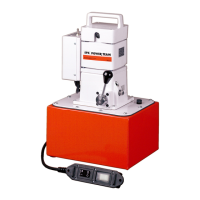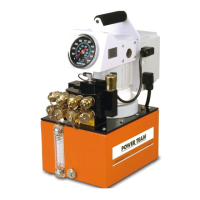Operating Instructions, Form No. 102875, Back sheet 2 of 8
SAFETY PRECAUTIONS (POWER SUPPLY) CONTINUED -
Air Driven Motor
• A quick disconnect must be installed in the air line to the pump.
• Disconnect air supply and relieve pressure when pump is not in use or when breaking any
connection in the hydraulic system.
• Control circuit m
ust comply with local directives and standards.
HYDRAULIC HOSES AND FLUID TRANSMISSION LINES
• Avoid straight line tubing connections in short runs. Straight line runs do not provide for expansion and
contraction due to pressure and/or temperature changes. See diagrams in “Set-up Instructions” section
of this form.
• Eliminate stress in the tube lines. Long tubing runs should be supported by brackets or clips. Tubes
through bulkheads must have bulkhead fittings. This makes easy removal possible and helps support the
tubing.
• Before operating the pump, all hose connections must be tightened with the proper tools. Do not
overtighten. Connections should only be tightened securely and leak-free. Overtightening can cause
premature thread failure or high pressure fittings to split at pressures lower than their rated capacities.
• Should a hydraulic hose ever rupture, burst, or need to be disconnected, immediately shut off the pump
and release all pressure. Never attempt to grasp a leaking pressurized hose with your hands. The force of
escaping hydraulic fluid could cause serious injury.
• Do not subject the hose to potential hazard such as fire, sharp surfaces, extreme heat or cold, or heavy
impact. Do not allow the hose to kink, twist, curl, crush, cut, or bend so tightly that the fluid flow within
the hose is blocked or reduced. Periodically inspect the hose for wear, because any of these conditions
can damage the hose and possibly result in personal injury. Ne
ver repair with tape.
•
Do not use the hose to move attached equipment. Stress can damage the hose and possibly cause
personal injury.
•
Hose material and coupler seals must be compatible with the hydraulic fluid used. Hoses also must not
come in contact with corrosive materials such as creosote-impregnated objects and some paints. Hose
deterioration due to corrosive materials can result in personal injury. Consult the manufacturer before
painting a hose. Never paint a coupler.
PUMP
• Do not exceed the hydraulic pressure rating noted on the pump nameplate or tamper with the internal
high pressure relief valve. Creating pressure beyond rated capacities can result in personal injury.
• Before replenishing the fluid level, retract the system to prevent overfilling the pump reservoir or bladder.
An overfill can cause personal injury due to excess reservoir or bladder pressure created when the
cylinders are retracted.
• Always shut off the motor or engine and relieve pressure before breaking any connections in the system.
• The motor or engine is the major part of the weight of the pump. Always take this into consideration
when lifting or moving the pump.
CYLINDER
• Do not exceed the rated capacities of the cylinders. Excess pressure can result in personal injury.
• Do not set poorly balanced or off-center loads on a cylinder. The load can tip and cause personal injury.
• Read and understand the cylinder operating instructions and warning decals before using the cylinder.
DANGER: A double-acting cylinder or ram must have both hoses and all couplers
securely connected to both ports. If one of the two ports is restricted or
becomes disconnected, pressure will build and the cylinder, hose or coupler
can burst, possibly causing serious injury or death.
HYDRAULIC FLUIDS
• Properly dispose of all fluids, components, and assemblies at the end of their useful life.
• Hydraulic fluid should be compatible with all hydraulic components.
